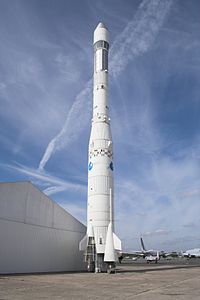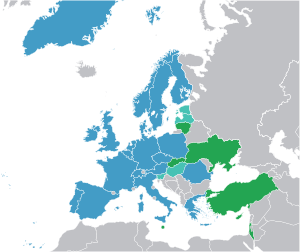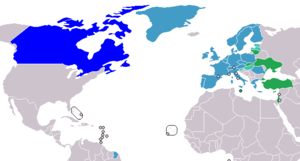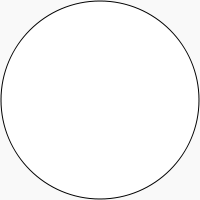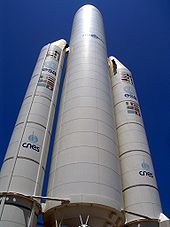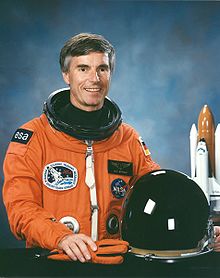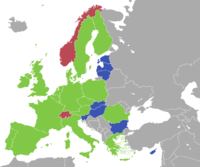
European Space Agency
Background to the schools Wikipedia
The articles in this Schools selection have been arranged by curriculum topic thanks to SOS Children volunteers. See http://www.soschildren.org/sponsor-a-child to find out about child sponsorship.
-
Evropská Kosmická Agentura (Czech)
Europæiske rumfartsorganisation (Danish)
Europese Ruimtevaartorganisatie (Dutch)
Euroopan avaruusjärjestö (Finnish)
Agence spatiale européenne (French)
Europäische Weltraumorganisation (German)
Ευρωπαϊκή Διαστημική Υπηρεσία (Greek)
Gníomhaireacht Spáis na hEorpa (Irish)
Agenzia Spaziale Europea (Italian)
Den europeiske romfartsorganisasjonen (Norwegian)
Europejska Agencja Kosmiczna (Polish)
Agência Espacial Europeia (Portuguese)
Agenţia Spaţială Europeană (Romanian)
Agencia Espacial Europea (Spanish)
Europeiska Rymdorganisationen (Swedish)
 |
|
| Owner | |
|---|---|
| Established | 1975 |
| Headquarters | Paris, France |
| Primary spaceport | Guiana Space Centre |
| Administrator | Jean-Jacques Dordain |
| Budget | |
| Official language(s) | English, French and German |
| Website | www.esa.int |
The European Space Agency (ESA) (French: l'Agence spatiale européenne - ASE; German: Europäische Weltraumorganisation) is an intergovernmental organisation dedicated to the exploration of space, currently with 20 member states. Established in 1975 and headquartered in Paris, France, ESA has a staff of more than 2,000 with an annual budget of about €4.02 billion / US$5.38 billion (2012).
ESA's space flight program includes human spaceflight, mainly through the participation in the International Space Station program, the launch and operations of unmanned exploration missions to other planets and the Moon, Earth observation, science, telecommunication as well as maintaining a major spaceport, the Guiana Space Centre at Kourou, French Guiana, and designing launch vehicles. The main European launch vehicle Ariane 5 is operated through Arianespace with ESA sharing in the costs of launching and further developing this launch vehicle.
ESA science missions are based at ESTEC in Noordwijk, Netherlands, Earth Observation missions at ESRIN in Frascati, Italy, ESA Mission Control ( ESOC) is in Darmstadt, Germany, the European Astronaut Centre (EAC) that trains astronauts for future missions is situated in Cologne, Germany, and the European Space Astronomy Centre is located in Villanueva de la Cañada, Spain.
History
Foundation
After World War II, many European scientists left Western Europe in order to work in the United States. Although the 1950s boom made it possible for Western European countries to invest in research and specifically in space related activities, Western European scientists realised solely national projects would not be able to compete with the two main superpowers. In 1958, only months after the Sputnik shock, Edoardo Amaldi and Pierre Auger, two prominent members of the western European scientific community at that time, met to discuss the foundation of a common western European space agency. The meeting was attended by scientific representatives from eight countries, including Harrie Massey (UK).
The Western European nations decided to have two different agencies, one concerned with developing a launch system ELDO (European Launch Development Organization) and the precursor of the European Space Agency, ESRO (European Space Research Organization). The latter was established on 20 March 1964 by an agreement signed on 14 June 1962. From 1968 to 1972, ESRO carried out numerous successful projects. Seven research satellites were brought into orbit, all by US launch systems. Ariane did not exist at that time.
ESA in its current form was founded with the ESA Convention in 1975, when ESRO was merged with ELDO. ESA has 10 founding member states: Belgium, Denmark, France, Germany, Italy, the Netherlands, Spain, Sweden, Switzerland and the United Kingdom. These signed the ESA Convention in 1975 and deposited the instruments of ratification by 1980, when the convention came into force. During this interval the agency functioned in a de facto fashion. ESA launched its first major scientific mission in 1975, Cos-B, a space probe monitoring gamma-ray emissions in the universe first worked on by ESRO.
End of space race
Beginning in the 1970s, when the space race between the US and the Soviet Union had cooled down and space budgets were cut dramatically in both countries, ESA established itself as a frontrunner in space exploration. ESA joined NASA in the IUE, the world's first high-orbit telescope, which was launched in 1978 and operated very successfully for 18 years. A number of successful Earth-orbit projects followed, and in 1986 ESA began Giotto, its first deep-space mission, to study the Comets Halley and Grigg-Skjellerup. Hipparcos, a star-mapping mission, was launched in 1989 and in the 1990s SOHO, Ulysses and the Hubble Space Telescope were all jointly carried out with NASA. Recent scientific missions in cooperation with NASA include the Cassini–Huygens space probe, to which ESA contributed by building the Titan landing module Huygens.
As the successor of ELDO, ESA has also constructed rockets for unmanned scientific and commercial payloads. Ariane 1, launched in 1979, brought mostly commercial payloads into orbit from 1984 onward. The next two developments of the Ariane rocket were intermediate stages in the development of a more advanced launch system, the Ariane 4, which operated between 1988 and 2003 and established ESA as the world leader in commercial space launches in the 1990s. Although the succeeding Ariane 5 experienced a failure on its first flight, it has since firmly established itself within the heavily competitive commercial space launch market with 56 successful launches as of September 2011. The successor launch vehicle of Ariane 5, the Ariane 6 is already in the definition stage and is envisioned to enter service in the 2020s.
The beginning of the new millennium saw ESA become, along with agencies like NASA, JAXA, ISRO, CSA and Roscosmos, one of the major participants in scientific space research. While ESA had relied on cooperation with NASA in previous decades, especially the 1990s, changed circumstances (such as tough legal restrictions on information sharing by the United States military) led to decisions to rely more on itself and on cooperation with Russia. A 2011 press issue thus stated:
Russia is ESA's first partner in its efforts to ensure long-term access to space. There is a framework agreement between ESA and the government of the Russian Federation on cooperation and partnership in the exploration and use of outer space for peaceful purposes, and cooperation is already under way in two different areas of launcher activity that will bring benefits to both partners.
Most notable for its new self-confidence are ESA's own recent successful missions SMART-1, a probe testing cutting-edge new space propulsion technology, the Mars Express and Venus Express missions as well as the development of the Ariane 5 rocket and its role in the ISS partnership. ESA maintains its scientific and research projects mainly for astronomy-space missions such as Corot, launched on 27 December 2006, a milestone in the search for extrasolar planets.
Mission statement
Since the Cold War ended with the fall of the Soviet Union's "iron curtain", space agencies around the world had to refocus and revise their visions and goals. In an interview with JAXA, the Japanese national space agency, Jean-Jacques Dordain ESA's Director General (since 2003) outlined briefly the European Space Agency's mission:
Today space activities are pursued for the benefit of citizens, and citizens are asking for a better quality of life on earth. They want greater security and economic wealth, but they also want to pursue their dreams, to increase their knowledge, and they want younger people to be attracted to the pursuit of science and technology. I think that space can do all of this: it can produce a higher quality of life, better security, more economic wealth, and also fulfil our citizens' dreams and thirst for knowledge, and attract the young generation. This is the reason space exploration is an integral part of overall space activities. It has always been so, and it will be even more important in the future.
Article II, Purpose, Convention of establishment of a European Space Agency, SP-1271(E) from 2003 also defines ESA's mission statement:
ESA's purpose shall be to provide for, and to promote, for exclusively peaceful purposes, cooperation among European States in space research and technology and their space applications, with a view to their being used for scientific purposes and for operational space applications systems:
- by elaborating and implementing a long-term European space policy, by recommending space objectives to the Member States, and by concerting the policies of the Member States with respect to other national and international organisations and institutions;
- by elaborating and implementing activities and programmes in the space field;
- by coordinating the European space programme and national programmes, and by integrating the latter progressively and as completely as possible into the European space programme, in particular as regards the development of applications satellites;
- by elaborating and implementing the industrial policy appropriate to its programme and by recommending a coherent industrial policy to the Member States.
Member states and budget
Membership and contribution to ESA
ESA is an intergovernmental organisation of 20 member states Member states participate to varying degrees in the mandatory (25% of total expenditures in 2008) and optional space programmes (75% of total expenditures in 2008). The 2008 budget amounted to €3.0 billion the 2009 budget to €3.6 billion. The total budget amounted to about €3.7 billion in 2010, €3.99 billion in 2011 and €4.02 billion in 2012.
The following table lists all the member states and adjunct members, their ESA convention ratification dates, and their contributions in 2012:
| Member state | ESA Convention | National Program | Contr. (mill. €) |
Contr. (%) |
|---|---|---|---|---|
| 30 December 1986 | FFG | 52.2 | 1.3% | |
| 3 October 1978 | BELSPO | 169.8 | 4.2% | |
| 12 November 2008 | CCMTSA | 11.5 | 0.3% | |
| 15 September 1977 | DTU Space | 27.8 | 0.7% | |
| 1 January 1995 | TEKES | 19.4 | 0.5% | |
| 30 October 1980 | CNES | 751.4 | 18.8% | |
| 26 July 1977 | DLR | 713.8 | 17.9% | |
| 9 March 2005 | ISARS | 8.6 | 0.2% | |
| 10 December 1980 | EI | 15.6 | 0.4% | |
| 20 February 1978 | ASI | 350.5 | 8.7% | |
| 30 June 2005 | Luxinnovation | 15.0 | 0.4% | |
| 6 February 1979 | NSO | 60.3 | 1.5% | |
| 30 December 1986 | NSC | 63.1 | 1.6% | |
| 19 November 2012 | CBK PAN | 36.4 | 0.9% | |
| 14 November 2000 | FCT | 15.8 | 0.4% | |
| 22 December 2011 | ROSA | 7.6 | 0.2% | |
| 7 February 1979 | INTA | 184.0 | 4.6% | |
| 6 April 1976 | SNSB | 65.3 | 1.6% | |
| 19 November 1976 | SSO | 105.6 | 2.6% | |
| 28 March 1978 | UKSA | 240.0 | 6.0% | |
| Associate Members | ||||
| 1 January 1979 | CSA | 18.7 | 0.5% | |
| Total Members and Associates | 2,900.1 | 72.1% | ||
| 28 May 2004 | ESP | 867.7 | 21.6% | |
| ECS states | various | various | 5.8 | 0.1% |
| Other income | — | — | 246.5 | 6.1% |
| Total ESA | 4,020.1 | 100.0% |
- ^ a b c These nations are considered initial signatories, but since they were members of neither ESRO nor ELDO (the precursor organizations to ESA) the Convention could only enter into force when the last of the other 10 founders ratified it.
- ^ a b c d e f g h i j Founding members and initial signatories drafted the ESA charter which entered into force on 30 October 1980. These nations were also members of either ELDO or ESRO.
- ^ a b c d e f g Acceded members became ESA member states upon signing an accession agreement.
- ^ Canada is an associated member of ESA.
- ^ Framework Agreement establishing the legal basis for cooperation between ESA and the European Union came into force in May 2004.
Associate members
Currently the only associated member of ESA is Canada. Previously associated members were Austria, Norway and Finland, all of which later joined ESA as full members.
Canada
Since 1 January 1979, Canada has had the special status of a Cooperating State within ESA. By virtue of this accord, the Canadian Space Agency takes part in ESA's deliberative bodies and decision-making and also in ESA's programmes and activities. Canadian firms can bid for and receive contracts to work on programmes. The accord has a provision ensuring a fair industrial return to Canada.
Budget appropriation and allocation
ESA budget chart by programme for 2011
The budget of ESA was €2.977 billion in 2005, €2.904 billion in 2006 and grew to €3.018 billion in 2008, €3.600 billion in 2009, €3.745 billion in 2010, €3.994 billion in 2011 and €4.020 billion in 2012. Every 3–4 years, ESA member states agree on a budget plan for several years at an ESA member states conference. This plan can be amended in future years, however provides the major guideline for ESA for several years. The last major conference was held at the end of 2008, setting the budget for the years to 2012.
The 2011 funding allocations for major areas of ESA activity are shown on the pie-chart on the right. The section called 'Other' includes Technology Development, Space Situational Awareness and spending related to European Cooperating States.
Countries typically have their own space programmes that differ in how they operate organisationally and financially with ESA. For example, the French space agency CNES has a budget double the amount it contributes to ESA. Several space-related projects are joint projects between national space agencies and ESA (e.g. COROT). Also, ESA is not the only European space organisation (for example European Union Satellite Centre).
Enlargement
After the decision of the ESA Council of 21/22 March 2001, the procedure for accession of the European states was detailed as described here. Nations who want to become a full member of ESA do so in 3 stages. First a Cooperation Agreement is signed between the country and ESA. In this stage, the country has very limited financial responsibilities. If a country wants to cooperate more fully with ESA, it signs a European Cooperating State (ECS) Agreement. The ECS Agreement makes companies based in the country eligible for participation in ESA procurements. The country can also participate in all ESA programmes, except for the Basic Technology Research Programme. While the financial contribution of the country concerned increases, it is still much lower than that of a full member state. The agreement is normally followed by a Plan For European Cooperating State (or PECS Charter). This is a 5-year programme of basic research and development activities aimed at improving the nation's space industry capacity. At the end of the 5-year period, the country can either begin negotiations to become a full member state or an associated state or sign a new PECS Charter. ESA is likely to expand quite rapidly in the coming years. Many countries, most of which joined the EU in both 2004 and 2007, have started to cooperate with ESA on various levels:
| Applicant state | Cooperation Agreement | ECS Agreement | PECS Charter(s) | ESA Convention | National Program |
|---|---|---|---|---|---|
| April 1991 | 7 April 2003 | 1st: 5 November 2003 2nd: 26 September 2008 |
2013 or later | HSO | |
| 15 July 2004 | TÜBİTAK | ||||
| 26 June 2007 | 10 November 2009 | 22 September 2010 | through MoEC | ||
| 25 January 2008 | SSAU | ||||
| 28 May 2008 | 22 January 2010 | 30 November 2010 | through MoHEST | ||
| 23 July 2009 | 19 March 2013 | through MoES | |||
| 27 August 2009 | through MoCW | ||||
| 28 April 2010 | through MoE | ||||
| 7 October 2010 | through MoE | ||||
| 30 January 2011 | ISA | ||||
| 20 February 2012 | through MCfST. |
EU countries and the European Space Agency
So far the only EU member state that has not signed an ESA Cooperation Agreement yet is Bulgaria. However, Bulgaria is in the process of signing a Cooperation Agreement.
![]() Bulgaria's progress towards ESA:
Bulgaria's progress towards ESA:
- On 9 April 2009, the Bulgarian Government announced Bulgaria's intention to participate in the activities of ESA through IKI-BAN.
- On 21 November 2011, Bulgaria became an official observer of ESA. The observer status that was granted allows Bulgaria to attend the ESA Council meetings for those matters of common interest between ESA and the EU.
- On the same date, Bulgaria entered negotiations with ESA about signing a Cooperation Agreement.
Launch vehicle fleet
ESA has a fleet of different launch vehicles in service with which it competes in all sectors of the launch market. ESA's fleet consists of three major rocket designs: Ariane 5, Soyuz-2 and Vega. Rocket launches are carried out by Arianespace, which has 23 shareholders representing the industry that manufactures the Ariane 5 as well as CNES, at the spaceport in French Guiana. Because many communication satellites have equatorial orbits, launches from French Guiana are able to take larger payloads into space than from spaceports at higher latitudes. In addition, equatorial launches give spacecraft an extra 'push' of nearly 500 m/s due to the higher rotation velocity of someone standing on the equator than near the Earth's axis where rotation velocity approaches nil.
Ariane 5
The Ariane 5 rocket is ESA's primary launcher. Its maximum estimated payload is 6-10 tons to GTO and up to 21 tons to LEO. The launch craft has been in service since 1997 and replaced Ariane 4. The Ariane 5 rocket exists in several variants, the heaviest being Ariane 5 ECA, which failed during its first test flight in 2002, but has since made twenty-two consecutive successful flights.
In November 2012 ESA agreed to build an upgrade of Ariane 5 called Ariane 5ME (Mid-Life Evolution) which will come into service in 2017 holding greater payloads. At the same time, the new engine for the upperstage of 5ME will be part of the Ariane 6 programme; the aim to develop a replacement launcher for Ariane 5. The details and final go-ahead for Ariane 6 will be decided in 2014.
ESA's Ariane 1, 2, 3 and 4 launchers (the last of which was ESA's long-time workhorse) have been retired.
Soyuz
Soyuz-2 (also called the Soyuz-ST or Soyuz-STK) is a Russian medium payload launcher (ca. 3 metric tons to GTO) which was brought into ESA service in October 2011. ESA entered into a €340 million joint venture with the Russian Federal Space Agency over the use of the Soyuz launcher. Under the agreement, the Russian agency manufactures Soyuz rocket parts for ESA, which are then shipped to French Guiana for assembly.
ESA benefits because it gains a medium payload launcher, complementing its fleet while saving on development costs. In addition, the Soyuz rocket—which has been the Russian's space launch workhorse for some 40 years—is proven technology with a very good safety record. Russia benefits in that it gets access to the Kourou launch site. Launching from Kourou rather than Baikonur will allow the Russians to almost double the Soyuz payload (3.0 tonnes vs. 1.7 tonnes to GTO), because of Kourou's closer proximity to the equator. Both agencies benefit from the long term strategic cooperation, which is also intended to enable future joint technology developments.
The maiden launch from Kourou was on 21 October 2011, for two European space navigation satellites. Three hours and 49 minutes after blast-off, the ESA announced that the two Galileo IOV-1 & IOV-2 satellites had successfully reached their final orbit 23,222 kilometres above Earth, and that their launch had been a complete success. The second Soyuz launch from French Guiana on the 16th of December 2011 was also a success. It was followed by another two successful launches from Kourou in 2012, making the first 4 launches with the Soyuz from South America successful.
Vega
Vega is ESA's small payload (ca. 1.5 metric tons to 700 km orbit) launcher. The leading ESA member state for the Vega Programme is Italy, contributing 65% of the costs. Vega itself has been designed to be a body launcher with three solid propulsion stages and an additional liquid propulsion upper module to place the cargo into the exact orbit intended. For a small-cargo rocket it is remarkable that Vega is able to place multiple payloads into orbit.
Vega's first and main stage (P80) is a direct modification of the Ariane 5 EAP (solid boosters) developed by CNES, the French space agency. The maiden launch was on 13 February 2012.
Human space flight
History
At the time ESA was formed, its main goals did not encompass human space flight; rather it considered itself to be primarily a scientific research organisation for unmanned space exploration in contrast to its American and Soviet counterparts. It is therefore not surprising that the first non-Soviet European in space was not an ESA astronaut on a European space craft; it was Czechoslovak Vladimír Remek who in 1978 became the first non-Soviet European in space (the first European in space being Yuri Gagarin of the Soviet Union) — on a Soviet Soyuz spacecraft, followed by the Pole Mirosław Hermaszewski and East German Sigmund Jähn in the same year. This Soviet co-operation programme, known as Intercosmos, primarily involved the participation of Eastern bloc countries. In 1982, however, Jean-Loup Chrétien became the first western European on a flight to the Soviet Salyut 7 space station.
Because Chrétien did not officially fly into space as an ESA astronaut, but rather as a member of the French CNES astronaut corps, the German Ulf Merbold is considered the first ESA astronaut to fly into space. He participated in the STS-9 Space Shuttle mission that included the first use of the European-built Spacelab in 1983. STS-9 marked the beginning of an extensive ESA/NASA joint partnership that included dozens of space flights of ESA astronauts in the following years. Some of these missions with Spacelab were fully funded and organizationally and scientifically controlled by ESA (such as two missios by Germany and one by Japan) with European astronauts as full crew members rather than guests on board. Beside paying for Spacelab flights and seats on the shuttles, ESA continued its human space flight co-operation with the Soviet Union and later Russia, including numerous visits to Mir.
During the latter half of the 1980s, European human space flights changed from being the exception to routine and therefore, in 1990, the European Astronaut Centre in Cologne, Germany was established. It selects and trains prospective astronauts and is responsible for the co-ordination with international partners, especially with regard to the International Space Station. As of 2006, the ESA astronaut corps officially included twelve members, including nationals from all the large Western European countries except the United Kingdom.
In the summer of 2008, the ESA started to recruit new astronauts so that final selection would be due in spring 2009. Almost 10,000 people registered as astronaut candidates before registration ended in June 2008. 8,413 fulfilled the initial application criteria. Of the applicants, 918 were chosen to take part in the first stage of psychological testing, which narrowed down the field to 192. After two-stage psychological tests and medical evaluation in early 2009, as well as formal interviews, six new members of the European Astronaut Corps were selected - five men and one woman.
Astronaut Corps
The astronauts of the European Space Agency are:
- ^ a b c d e have visited Mir
- ^ a b c d e f 2009 selection
- ^ a b c d e f g h i j k have visited the International Space Station
- ^ a b c d e retired now
Manned launch vehicles
In the 1980s France pressed for an independent European manned launch vehicle. Around 1978 it was decided to pursue a reusable spacecraft model and starting in November 1987 a project to create a mini-shuttle by the name of Hermes was introduced. The craft itself was modelled comparable to the first proposals of the Space Shuttle and consisted of a small reusable spaceship that would carry 3 to 5 astronauts and 3 to 4 metric tons of payload for scientific experiments. With a total maximum weight of 21 metric tons it would have been launched on the Ariane 5 rocket, which was being developed at that time. It was planned solely for use in Low-Earth orbit space flights. The planning and pre-development phase concluded in 1991; however, the production phase was never fully implemented because at that time the political landscape had changed significantly. With the fall of the Soviet Union ESA looked forward to cooperation with Russia to build a next-generation human space vehicle. Thus the Hermes program was cancelled in 1995 after about 3 billion dollars had been spent. The Columbus space station program had a similar fate.
In the 21st century ESA started new programs in order to create its own manned spacecraft, most notable among its various projects and proposals is Hopper, whose prototype by EADS, called Phoenix, has already been tested. While projects such as Hopper are neither concrete nor to be realised within the next decade, other possibilities for human spaceflight in cooperation with the Russian Space Agency have emerged. Following talks with the Russian Space Agency in 2004 and June 2005, a cooperation between ESA and the Russian Space Agency was announced to jointly work on the Russian-designed Kliper, a reusable spacecraft that would be available for space travel beyond LEO (e.g. the moon or even Mars). It was speculated that Europe would finance part of it. However, a €50 million participation study for Kliper, which was expected to be approved in December 2005, was finally not approved by the ESA member states. The Russian state tender for the Kliper project was subsequently cancelled in the summer of 2006.
In June 2006 ESA member states granted 15 million to the Crew Space Transportation System (CSTS) study, a two-year study to design a spacecraft capable of going beyond Low-Earth orbit based on the current Soyuz design. This project is pursued with Roskosmos instead of the previously cancelled Kliper proposal. A decision on the actual implementation and construction of the CSTS spacecraft is contemplated for 2008, with the major design decisions being made before the summer of 2007. In mid-2009 EADS Astrium was awarded a €21 million study into designing a manned variation of the European ATV vehicle which is believed to now be the basis of the Advanced Crew Transportation System design.
In November 2012 ESA decided to join NASA's Orion programme. The ATV would form the basis of a propulsion unit for NASA's new manned spacecraft. ESA may also seek to work with NASA on Orion's launch system as well in order to secure a seat on the spacecraft for its own astronauts.
Cooperation with other countries and organisations
ESA has signed cooperation agreements with the following states that currently neither plan to integrate as tightly with ESA institutions as Canada, nor envision future membership of ESA: Argentina, Brazil, China, India (for the Chandrayan mission), and Russia.
Additionally, ESA has joint projects with the European Union, NASA of the United States and is participating in the International Space Station together with the United States (NASA), Russia and Japan (JAXA).
European Union
ESA is not an agency or body of the European Union (EU), and has non-EU countries Switzerland and Norway as members. There are however ties between the two, with various agreements in place and being worked on, to define the legal status of ESA with regard to the EU.
There are common goals between ESA and the EU, and ESA has an EU liaison office in Brussels. On certain projects, the EU and ESA cooperate, such as the upcoming Galileo satellite navigation system. Space policy has since December 2009 been an area for voting in the European Council. Under the European Space Policy of 2007, the EU, ESA and its Member States committed themselves to increasing coordination of their activities and programmes and to organising their respective roles relating to space.
The Lisbon Treaty of 2009 reinforces the case for space in Europe and strengthens the role of ESA as an R&D space agency. Article 189 of the Treaty gives the EU a mandate to elaborate a European space policy and take related measures, and provides that the EU should establish appropriate relations with ESA.
Former Italian astronaut Umberto Guidoni, during his tenure as a Member of the European Parliament from 2004 to 2009, stressed the importance of the European Union as a driving force for space exploration, "since other players are coming up such as India and China it is becoming ever more important that Europeans can have an independent access to space. We have to invest more into space research and technology in order to have an industry capable of competing with other international players."
The first EU-ESA International Conference on Human Space Exploration took place in Prague on 22 and 23 October 2009. A road map which would lead to a common vision and strategic planning in the area of space exploration was discussed. Ministers from all 29 EU and ESA members as well as members of parliament were in attendance.
National space organisations of member states
- The Centre National d'Études Spatiales (CNES) (National Centre for Space Study) is the French government space agency (administratively, a "public establishment of industrial and commercial character"). Its headquarters are in central Paris. CNES is the main participant on the Ariane project. Indeed CNES designed and tested all Ariane family rockets (mainly from its centre in Évry near Paris)
- The UK Space Agency is a partnership of the UK government departments which are active in space. Through the UK Space Agency, the partners provide delegates to represent the UK on the various ESA governing bodies. Each partner funds its own programme.
- The Italian Space Agency (Agenzia Spaziale Italiana or ASI) was founded in 1988 to promote, coordinate and conduct space activities in Italy. Operating under the Ministry of the Universities and of Scientific and Technological Research, the agency cooperates with numerous entities active in space technology and with the president of the Council of Ministers. Internationally, the ASI provides Italy's delegation to the Council of the European Space Agency and to its subordinate bodies.
- The German Aerospace Centre (DLR) (German: Deutsches Zentrum für Luft- und Raumfahrt e. V.) is the national research centre for aviation and space flight of the Federal Republic of Germany and of other member states in the Helmholtz Association. Its extensive research and development projects are included in national and international cooperative programmes. In addition to its research projects, the centre is the assigned space agency of Germany bestowing headquarters of German space flight activities and its associates.
- The Instituto Nacional de Técnica Aeroespacial (INTA) (National Institute for Aerospace Technique) is a Public Research Organization specialized in aerospace research and technology development in Spain. Between other functions, it serves as a platform for space research and acts as a significant testing facility for the aeronautic and space sector in the country.
NASA
ESA has a long history of collaboration with NASA. Since ESA's astronaut corps was formed, the Space Shuttle has been the primary launch vehicle used by ESA's astronauts to get into space through partnership programs with NASA. In the 1980s and 1990s, the Spacelab program was an ESA-NASA joint research program that had ESA develop and manufacture orbital labs for the Space Shuttle for several flights on which ESA participate with astronauts in experiments.
In robotic science mission and exploration missions, NASA has been ESA's main partner. Cassini–Huygens was a joint NASA-ESA mission, the Infrared Space Observatory, INTEGRAL, SOHO, and others. Also, the Hubble space telescope is a joint project of NASA and ESA. Future unmanned projects that are in development right now and are ESA-NASA joint projects include the James Webb Space Telescope or the Laser Interferometer Space Antenna. NASA and ESA will also likely join together for a Mars Sample Return Mission.
Cooperation with other space agencies
Since China has started to invest more money into space activities, the Chinese Space Agency has sought international partnerships. ESA is, beside the Russian Space Agency, one of its most important partners. Recently the two space agencies cooperated in the development of the Double Star Mission.
ESA entered into a major joint venture with Russia in the form of the CSTS, the preparation of French Guyana spaceport for launches of Soyuz-2 rockets and other projects. With India ESA agreed to send instruments into space aboard the ISRO's Chandrayaan-1 in 2008. ESA is also cooperating with Japan, the most notable current project in collaboration with JAXA is the BepiColombo mission to Mercury.
Speaking to reporters at an air show near Moscow in August 2011, ESA head Jean-Jacques Dordain said ESA and Russia's Roskosmos space agency would "carry out the first flight to Mars together."
International Space Station
With regard to the International Space Station (ISS) ESA is not represented by all of its member states: 10 of the 20 ESA member states currently participate in the project. ESA is taking part in the construction and operation of the ISS with contributions such as Columbus, a science laboratory module that was brought into orbit by NASA's STS-122 Space Shuttle mission and the Cupola observatory module that was completed in July 2005 by Alenia Spazio for ESA. The current estimates for the ISS are approaching €100 billion in total (development, construction and 10 years of maintaining the station) of which ESA has committed to paying €8 billion. About 90% of the costs of ESA's ISS share will be contributed by Germany (41%), France (28%) and Italy (20%). German ESA astronaut Thomas Reiter was the first long-term ISS crew member.
As of 2008, the spacecraft establishing supply links to the ISS are the Progress, Soyuz and Space Shuttle. ESA has developed the Automated Transfer Vehicle (ATV) for ISS resupply. Each ATV has a cargo capacity of 7,667 kilograms (16,900 lb). The first ATV, Jules Verne, was launched on 9 March 2008 and on 3 April 2008 successfully docked with the ISS. This manoeuvre, considered a major technical feat, involved using automated systems to allow the ATV to track the ISS, moving at 27,000 km/h, and attach itself with an accuracy of 2 cm. No other spacefaring nations or space agency currently possess this level of autonomy in rendezvous and docking activities, considered key to future space exploration. With the Space Shuttle's retirement in 2011, until NASA has a replacement for it such as COTS the ATV together with Progress, Soyuz and the Japanese transporter HTV are the only links between Earth and the ISS.
European Life and Physical Sciences research on board the International Space Station (ISS) is mainly based on the ELIPS programme that was initiated in 2001.

